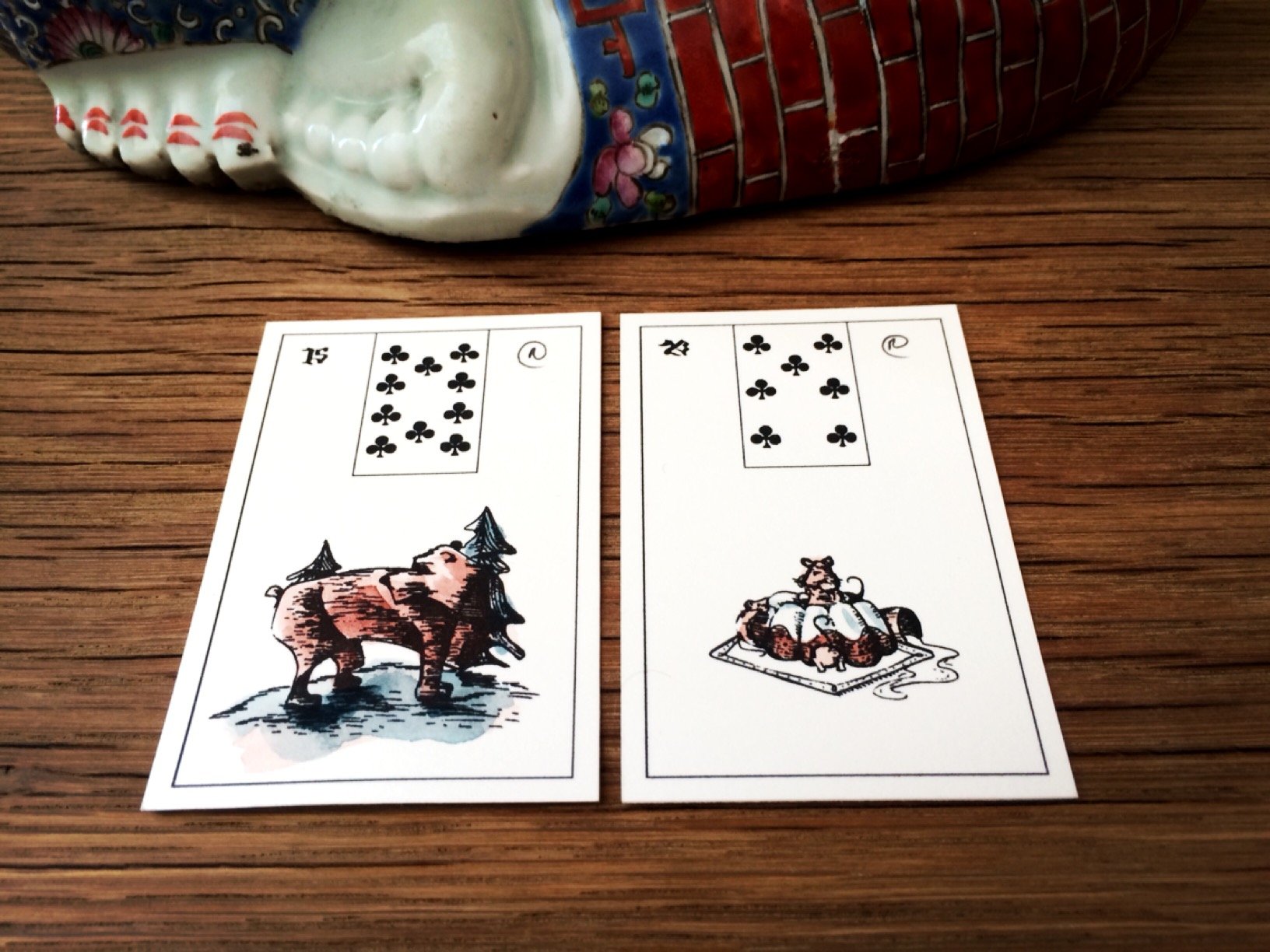What of the Bear?
As I keep preaching that insofar as language is based on random glyphs chosen conventionally – and thus operates with symbolic value not inherent meaning – what we must look at when we read a visual text is what function the image performs before we get ‘deep’ with a presupposed symbolic content.
With the Lenormand cards
it’s rather painfully easy: Before the Letter ‘means’ message, it is a message. The Letter performs the function of transmitting the written word from one person to another. There’s nothing symbolic here. The only symbolic value there is is found in our cultural conditioning: if we see the Letter as a symbol of communication, we do so because we’ve decided that this is the case, not because we got hit in our heads by divine inspiration dictating a privileged meaning.
In my teachings I’m not interested in privileged meanings. In fact, if I stumble over any, I swing my very sharp katana, or my samurai sword, and slash the hell out of it. When I claim that what I practice is martial arts cartomancy, I’m not even kidding.
Let’s look now at a concrete example that keeps coming up in my classes, when the students complain that they don’t know what to do with a card like the Bear. Too many meanings. They see the Bear as a challenging example, as this card prevents them from achieving coherence. Too many meanings.
What can we do about it?
Here’s a lesson for everyone that will help you think about how you can tackle this problem. It’s also a testimony of my style of teaching and what you can expect, should you like to try some martial arts cartomancy.
Bear means only one thing. Not 10 things. One thing.
Each card means only one thing simply because you have a question to begin with. Without a question what you have connected to the idea of a symbol becomes a random string of words, a list. In introduction books you will stumble over this notion: Bear equals finance, power, strength, inheritance, mother, and so on.
So you read these words and think to yourself, following your innate wisdom that identifies what’s wrong here: you can’t cook a perfect pie with ingredients, not even when you have all the right ones. What you need is a basic recipe. You start with that.
An introduction book can be filled with brilliant ideas and hundreds of assumptions (some are wrong assumptions). But if there’s no narrative of how to get coherent at creating a story, then the book is useless.
It’s not enough to get excited about having learnt grammar. It’s not enough that you have an epiphany: ‘Oh, I get it now, I can read the Lenormand cards by creating a sentence with my nouns, verbs, and complements.’ The reality is that you can create a most perfect sentence that goes nowhere. So you have to learn how to put your sentence to use if it is to address the question at hand.
Let’s go back to the Bear.
What do you know of Bear? It’s an animal that is big and dangerous if you meet it in the wild. Bear can overpower you. Now think of Bear next to another card, say, the Mice.
What do you know of a mouse? It’s an animal that is small and pesky if you catch it in your house eating your things. You can overpower a mouse by trapping it.
Now imagine you have a question about money:
Will I get more of it?
The first card down is Child. What do you know of ‘Child’? That it’s human, small, playful, cute, or a pest when it throws tantrums.
Now related to money: Do any of the cards on the table, Child, Bear, and Mice relate to finances? Only symbolically via each card’s function: The Child will lose it, the Bear will hide it, and the Mice will waste it.
What have we done here? Identify the function behind each card at the first indexical level, which is to say, the first level of embodiment. So we go with the physical and the concrete, not the symbolic and the intangible.
Sometimes these levels are mixed to your detriment when you stretch the symbolic into what you think is real – because you read it in a book – but in reality is not. A Bear is not a Boss before it’s a Bear. Please remember this before you jump at ‘meanings’. What comes first, the basic nature and quality of the card, is not its symbolic representation.
You will hear in the cartomantic community the excitement about how wonderfully literal the Lenormand is, and then, if you pay close attention, you will observe how everyone gleefully proceeds to reading everything symbolically.
It’s not enough to know in theory that we have literalness, and never apply it consistently. This is exactly where the crux of the problem is, namely that literalness is not applied consistently. And why? Because people forget that there’s such a thing as an order of signification. Hence we get completely random mixes of ‘meanings’ going from embodied attitudes – now you’re literal until it’s more convenient for you to not be literal anymore – to a rehearsed cliché: ‘Lily means sex.’ Really?
Back to the question: Will I get more money?
No. In your imagination (Child) you mirror your smallness into a projected big shadow on the wall (Bear). ‘Oh, I have so much potential.’ Maybe. But merely mirroring the projection of financial strength is not the same as having financial strength. In fact it’s a waste of imaginative power to project money in a scattered way.
Mice are not exactly known for their focus. They are known to get things done. They eat everything in their range. But this activity is not the result of focus. So, wait a minute, how can I talk about projections when I don’t even have the Moon card on the table? Isn’t that the one that ‘means’ reflection, or recognition at work, reputation, being in the limelight, dreams, poetry, deceit? Blah blah blah…
I can talk about projections because a Child is good at it. A Child mirroring Mice tells me that there’s an unregulated flow of ideas, in the sense that there’s little self-reflection about how great power can be embodied. There’s simply too much distraction in play (Child) and scattered productivity (Mice) for the Bear to maintain momentum (of power and size) – growing financial size here, if we keep to the focus of the question.
So the Bear card, which could be a sign of solid money, flanked by two cards that lack focus, stands no chance to suggest growing. Now, did I just say, ‘growing’? I did. Simply because that is what the question was about. We never want to forget the question. What was it again? Can I get more money? Right.
So what we’re looking for when we read the cards is any sign of growth of financial power. What we are so most definitely not looking for is positive and negative cards. What is that, anyway? ‘This is positive, this is negative.’ Positive and negative in relation to what?
While a good diviner is aware of the power of dualist language and how to use it, an extraordinary diviner will know that merely categorizing labels according to value that’s divided, good/bad, man/woman, big/small, is not where it’s at. Where it’s at is looking at how images play a game on you, always going in and out of perspective.
On the other hand, what I’m also saying is that while you can arrive at the above conclusion by simply activating your Lenormand ‘list vocabulary’ and divisions of the positive and negative kind, you can do better. You can hit the right mark by demonstrating more than your basic understanding of how a coherent reading is crafted. You can demonstrate fearlessness in subjecting yourself to randomness and to possibility, but not the kind of randomness and possibility that renders you in the ditch of postulations: ‘It can also mean that.’
Actually, no, if you cared to look closely. Randomness is a 50/50 thing. Sometimes you get it, sometimes you don’t. The coherent story, that is. Prediction is in another class, though also subject to the same law of 50/50. Why? Simply because we never operate with anything in life than the 50/50 variable. So in reading cards. Why again? Simply because every reading is subject to conditions that change. Life events are constantly subject to conditions that change. It’s the law of impermanence.
What I’m also saying is that if you know your basics at the profound level you can be sure to have an argument for every single statement you make that will not be vague or embodying polysemy – ‘it can also mean that’ – or a participation in maintaining a discourse based on uninteresting and useless clichés.
What I teach when I teach cartomancy is awareness of what you can do with a visual text beyond all your fears, especially the fear of not quite remembering what you were told to memorize. Reading like the Devil is not about memory. It’s about situating signification in context based on seeing what is actually the case.
♠
Cards: Ryan Edward’s Maybe Lenormand, 2018.
*
The Read Like the Devil Lenormand
More of this? Get the book. It points to just where the students go wrong, and then demonstrates how we can apply a method to more credible solutions.





